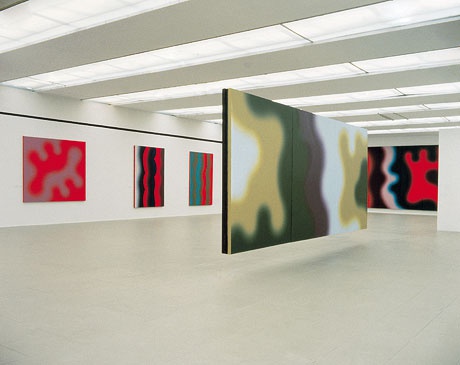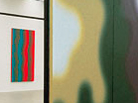Wojciech Fangor — painting, drawing and spatial forms

About the collection
In 1999 Wojciech Fangor returned to Poland after 38 years of staying abroad. He had left Poland in 1961, in 1966 emigrated to the USA, and since 1989 lived in Santa Fe, New Mexico. There — in connection with his monographic exhibition planned for 1990 at the Zachęta Gallery in Warsaw — he decided to donate Poland a large collection of his works. Thus the collection was taken over by the Polish Cultural Foundation. It consists of 109 works, including 84 pictures and 25 drawings from various periods, which have been gathered by the artist convinced they are the important and representative works for his output. The exhibition ‘Wojciech Fangor. 50 years of painting’ was presented at the Zachęta Gallery in Warsaw in October 1990, accompanied with a special catalogue. The artist‘s wish was to give the whole collection to one institution; with the artist’s approval the Foundation has placed the collection at the district museum in Radom.
In 1994 pictures from the collection were shown for the first time at the district museum in Radom; the exhibition was prepared by the artist in collaboration with Piotr Zanecznik, the son of Stanisław. A year later two exhibitions were held, one at the museum in Chełm, and the other at the BWA Old Gallery in Lublin. Fangor’s large donation for the Polish nation is preserved at the district museum in Radom, which today carries the name of Jacek Malczewski (the full name is the Jacek Malczewski Museum of Modern Art. The collection has never been shown so far in full in one place. Some pictures from among the total number of 84 are of a very large format (5 or even 6 metres long). The set could fill a separate exposition hall. It is the largest and most important collection amongst the gatherings of the museum which started its activity in 1990. After five years of its activity, on the occasion of its first jubilee, the museum showed a set of Fangor’s drawings in 1996.
Now, presenting Fangor’s creation at the BWA Contemporary Art Gallery in Katowice, I would like to remind you that some pictures belonging to this large collection have already been shown here twice: in 1995 at the exhibition Art of Energetic Mediations r (curator Józef Robakowski), and in 2000 r at the exhibition ‘Language of Geometry II’ which was originated by Bożena Kowalska.
Giving his precious donation in 1989, Wojciech Fangor didn’t plan to come back to Poland. But in 1995, teaching painting at an American school in southern France, where he tried to settle for longer, he started to think about his return to Poland.
About the exhibition
The present exhibition in Katowice is the first large solo exhibition of Wojciech Fangor since his come back to Poland; it has been prepared on the occasion of his 80th anniversary. The majority of works presented at the exhibition come from the period of his creation, which is called by him a period of ‘positive illusive space’ (the years 1957-1973). He discovered then that an illusion of space is possible, which develops in an opposite direction as compared to the renaissance one, i.e. not towards the depth of a picture, but towards the viewer. Optical illusions (a strong pulsating effect) which appear in these abstractive pictures (circles, and then waves) made that his pictures have been associated with op-art. And just these pictures aroused audience’s interest in Europe and America and brought him a success.
In books devoted to contemporary art in Poland and at exhibitions showing its history, Wojciech Fangor’s art has often been presented by his pictures of pulsating circles. The artist, however, has been undertaking new investigations also later. These investigations are connected with the analysis of seeing; the seeing is dictating the image which becomes the subject of the analysis. Curators of this exhibition aimed at attracting our attention to his almost newest pictures of the 90s, represented here by the cycle of ‘Chairs’. These pictures were shown in April this year at the Rogatka Gallery in Radom along with their models, i.e. real chairs, standing in front of them on pedestals. This was provoking questions about reality and its image; paradoxically his images seemed to be real, while the real chairs seemed to be a spatial projection; thus the exhibition was letting us realise once again an unusual force of his pictures, even in cases when, it could seem, the painter was returning to his beginnings on the way of modern artistic investigations.
The exhibition begins with a set of landscapes from the suburban vicinities of Warsaw (Wilanów, Klarysew), painted around 1948, which today we could define as cubist in character. His pictures of the 40s, which begin the exhibition, as well as those of the 90s, which close it, are close to each other, creating a kind of bridge which is very important for the whole exhibition. Wojciech Fangor is not only an originator of geometrical abstraction; this was only one particular moment in his creative investigation.
Mieczysław Szewczuk, co-curator of the exhibition (Modern Art Museum in Radom)

The exhibition of works by Wojciech Fangor (born in 1922) was opened on June 21st, 2002 at the BWA Contemporary Art Gallery in Katowice. The opening was combined with the promotion of Bożena Kowalska’s book entitled ‘Fangor, a Painter of Space’, published in 2001 by the Polish publishing houses Wydawnictwa Artystyczne i Filmowe and Państwowe Wydawnictwo Naukowe. The book was awarded at the 42nd Polish Publishers Contest as the ‘Most Beautiful Book of the Year 2001’.
Wojciech Fangor belongs to the most outstanding Polish painters. He debuted in 1949 with his solo exhibition at the Young Artists and Scientists Club Gallery in Warsaw, run by Marian Bogusz. Fangor is an originator of the first environment in the world, which was realised in 1958 (with participation of his friend, an artist/architect Stanisław Zanecznik) at the Salon Nowej Kultury in Warsaw. The show was entitled ‘Study of a Space’. Space is the main problem also in his pictures.
In 1961 Fangor left Poland, having resigned from the position of a professor at the Academy of Fine Arts in Warsaw. At first he stays in Europe: Austria, France and Germany, where his art gains a lot of public interest, and then moves to the United States (1966), where he gets the Professor position at the faculty of painting of the Fairleigh Dickinson University in Madison, New York.
His paintings presenting abstract pulsating colour circles and waves have won general recognition and great popularity. Fangor is the only Polish artist who was invited to participate in the famous international exhibition ‘The responsive Eye’ at the Museum of Modern Art in New York in 1965, and the only Polish artist who presented his solo exhibition at the Guggenheim Museum in New York (1970).
After 1975 the artist returned to figurative painting which has an individual character of a few different stages.
From his rich and many-sided output, the curators of the exhibition in Katowice have selected Fangor’s pieces belonging to only three stages of his artistic activity to be shown at the exhibition. This includes as follows:
1. the early stage; figurative paintings of cubist character (ca. 1949),
2. the abstract stage; investigations in the area of space, movement and colour, starting from the photographic documentation Space Study (the years 1958-1975); this is the core of the exhibition,
3. the newest stage including recent decades; furniture portraits, mainly chairs.
Curators: Bożena Kowalska and Mieczysław Szewczuk

